
Huntsman spiders, members of the family Sparassidae, are known by this name because of their speed and mode of hunting. They are also called giant crab spiders because of their size and appearance. Larger species sometimes are referred to as wood spiders, because of their preference for woody places. In southern Africa the genus Palystes are known as rain spiders or lizard-eating spiders. Commonly, they are confused with baboon spiders from the Mygalomorphae infraorder, which are not closely related.
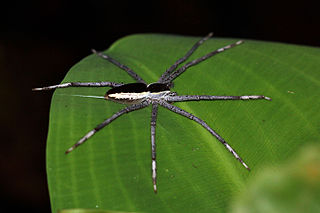
Nursery web spiders (Pisauridae) are a family of araneomorph spiders first described by Eugène Simon in 1890. Females of the family are known for building special nursery webs. When their eggs are about to hatch, a female spider builds a tent-like web, places her egg sac inside, and stands guard outside, hence the family's common name. Like wolf spiders, however, nursery web spiders are roaming hunters that don't use webs for catching prey.

Epeus is a genus of the spider family Salticidae. They are often found on broad-leaved plants or shrubs of rain forest, or in gardens of Southeast Asia.

Telamonia is a genus of jumping spiders that was first described by Tamerlan Thorell in 1887. They are colorful spiders, with patterns that vary considerably between sexes and species. Two longitudinal stripes along the abdomen are common, and the carapace is often colored. They have a slender opisthosoma and long legs.

Pisaura is a genus of Eurasian spiders in the family Pisauridae.
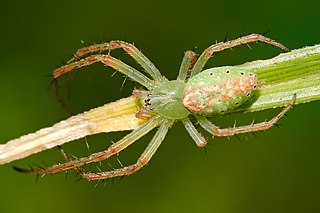
Cyrtophora, the tent-web spiders, is a genus of orb-weaver spiders first described by Eugène Simon in 1895. Although they are in the "orb weaver" family, they do not build orb webs. Their tent-like, highly complex non-sticky web is sometimes considered a precursor of the simplified orb web. These webs are aligned horizontally, with a network of supporting threads above them. These spiders often live in colonies. Females have a body length of mostly about 10 millimetres (0.39 in) long. Some members, including Cyrtophora cicatrosa, exhibit the ability to change colour rapidly.
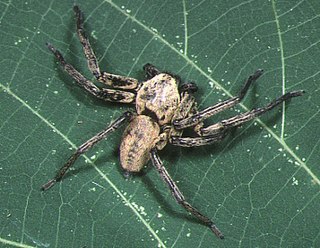
Thelcticopis is a genus of huntsman spiders that occurs almost exclusively in the area India to Japan to New Guinea and Fiji. However, one species occurs in Costa Rica, and another in Congo basin, although the latter species is probably misplaced in this genus.
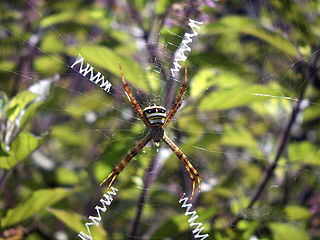
Argiope anasuja, is a species of harmless orb-weaver spider found from the Seychelles to India, Pakistan, Nepal, Sri Lanka, Maldives and in the Brazil.

Acanthoscurria theraphosoides is a species of spider from the family Theraphosidae (tarantulas), found in Peru, Bolivia, Brazil, and French Guiana.

Argiope catenulata, also known as the grass cross spider, is a species of orb-weaver spiders ranging from India to the Philippines and Papua New Guinea, and also found in Australia in 2019. Like other species of the same genus, it builds a web with a zig-zag stabilimentum.
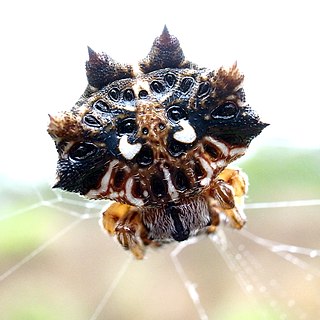
Thelacantha is a genus of orb-weaver spiders containing the single species, Thelacantha brevispina. It was first described by A. W. M. van Hasselt in 1882, and has been found in Australia, Madagascar, and across southern Asia from India to Philippines, including Japan. It has also been introduced into Hawaii. T. brevispina is closely related those in the genus Gasteracantha, and was briefly synonymized with it in 1859, but revalidated in 1974. Saito described three other Thelacantha species in 1933, which were later synonymized with T. brevispina.

Araneus mitificus, commonly known as the kidney garden spider or pale orb weaver is a species of orb-weaver spider found in South, East, and Southeast Asia.
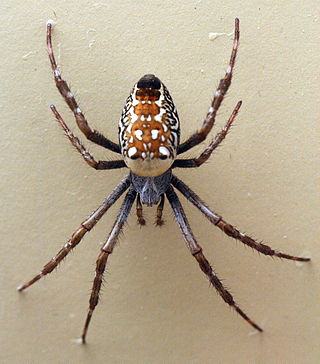
Cyrtophora moluccensis is a tent-web spider in the orb-weaver family. It is commonly known as the tent spider or dome-web spider, and is native to India, Japan, Indonesia, Papua New Guinea, Australia, Fiji, and Tonga. It is often found in disturbed or open habitats from coasts to forest and mountainous interiors.

Euryattus bleekeri, known as Bleeker's jumping spider, is a species of spider in the family Salticidae. It is found from Sri Lanka to Queensland.
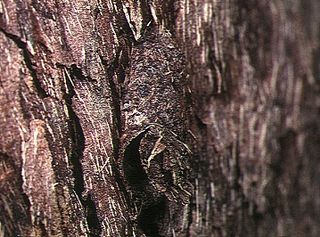
Conothele is a genus of mygalomorph spiders in the family Halonoproctidae, first described by Tamerlan Thorell in 1878. Originally placed with the Ctenizidae, it was moved to the Halonoproctidae in 2018.
Dendrolycosa is a genus of nursery web spiders that was first described by Carl Ludwig Doleschall in 1859.

Nilus is a genus of nursery web spiders that was first described by Octavius Pickard-Cambridge in 1876.
Sphedanus is a genus of Asian nursery web spiders that was first described by Tamerlan Thorell in 1877. As of June 2019 it contains only three species, found only in Asia: S. banna, S. quadrimaculatus, and S. undatus.

Acusilas coccineus is a species of spider in the family Araneidae, found from India and China to Indonesia. In India particularly, it has been known by the synonym Phonognatha vicitraSherriffs, 1928, but this is based on a misidentification. In India, it is found in woodlands and among shrubs. It is a small orb-weaver.

Argiope versicolor, the multi-coloured Saint Andrew's cross spider, is a species of orb-weaver spider found mostly in Southeast Asia, from China to Indonesia.


















